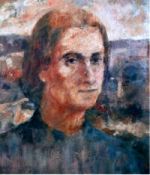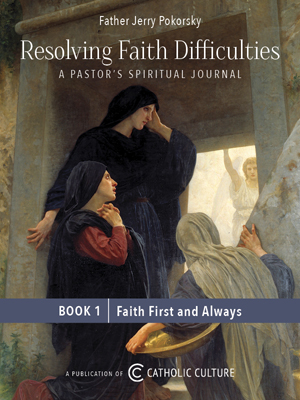From Our Lady’s Dowry
by Zsolt Aradi
The England of the eleventh and twelfth centuries shared with the other parts of Europe in veneration of Our Lady, and early in this period a famous shrine in her honor sprung up in the calm and lovely countryside near Norfolk, three miles from the sea. Its origins are obscure, but according to the legend a noble widow, Richeldis de Favershes, said that in a vision the Mother of God had led her in spirit to the little house of the holy family in Nazareth, bidding her to build a replica of it in England in honor of the Annunciation. This little house was built and is said to have endured for four hundred years; paneled with wood, its darkness was lit with tapers and, as time went on and many pilgrims came with gifts, it gleamed with gold, silver and precious stones. And from a seal preserved from the thirteenth century we know that it contained a figure of Our Lady enthroned with the Child in her left arm. This is one of the most beautiful medieval representations of Mary, "The Seat of Wisdom."
In time the small house built by Lady Richeldis was enshrined in a splendid Lady Chapel and in the thirteenth century, during the reign of Edward the Conqueror, a great Priory Church was erected beside it for the Augustinian Canons who were made the guardians of the shrine. Walsingham was not the only place of pilgrimage to Our Lady in England, but it became the most famous of them all. In those days when men's minds were often fixed upon the holy places, it was considered the New Nazareth, the shrine that honored above all the Mystery of the Incarnation. It was chiefly because of the importance of Walsingham that England received her titles, "the Holy Land" and "Our Lady's Dowry."
To Walsingham came the faithful from all parts of the Continent and the British Isles--kings and many great figures of early English history. To this day the main road of the pilgrims through Newmarket, Brandon and Fakenham is still called "the Palmers' Way." Indeed so constant was the stream that after the fourteenth century the approach to the Lady Chapel was guarded by still another shrine dedicated to St. Catherine of Mount Sinai: the "Slipper Chapel," as it was called, the word deriving from slype, i.e, "way through."
Countless writings bear witness to the influence of Walsingham in these days, but perhaps we should use the words of Erasmus of Rotterdam, whose critical mind did not hesitate to mock the spurious, whose sarcasms have survived the centuries. Before Our Lady of Walsingham he bowed his head in filial devotion and a votive ode according to the mode of his age, in Greek, tells us of his sentiments in visiting that hallowed spot.
Rich in goodwill, but poor in all beside,
Bring thee my verse--nought have I else to bring--
And beg, in quittal of this worthless gift,
That greatest meed--a heart that feareth God,
And free for aye from sin's foul tyranny.
--Erasmus, his vow.
Twenty-seven years after Erasmus wrote his poem, "Walsingham," the diamond in Our Lady's Dowry was no more. In 1538, during the reign of Henry VIII, Walsingham was desecrated by the enemies of the Church, totally destroyed, and its sacred image carried to Chelsea and burned. The unknown sixteenth century poet in his "Lament for Walsingham" expresses something of what the people felt at the loss of their glorious shrine:
Whose days are night:
Blessings turned to blasphemies,
Holy deed to spite;
Sin is where Our Lady sate:
Heaven is turned to hell:
Satan sits where Our Lord did sway--
Walsingham, oh, farewell.
Walsingham fell into complete oblivion. For five centuries the little house of Nazareth, the Lady Chapel, the Priory Church, the innumerable road chapels that led to the heart of the great shrine, and even the memory of this holy place lived only in the heart of a few. And even these memories became a legend…
But Walsingham is not a legend today. The records, the documents and archives of the miracles, which were once performed there have been destroyed, but another miracle has taken place. In the nineteenth century some archaeologists were fortunate enough to find in their excavations some important remnants of the holy place. Events followed in rapid succession and were intimately connected with other new signs of life in the Catholic Church in England. Search of old documents revealed that an ancient building used as a barn was in reality the Slipper Chapel, once dedicated to St. Catherine as protectress of the House of Nazareth. This chapel was built probably in 1338 and it is unusually small: 12 feet 5 inches by 28 feet 6 inches. Its details and its location make the Slipper Chapel "one of the architectural gems of fourteenth century England." After the first archaeological discoveries toward the end of the nineteenth century, before the existence of the Slipper Chapel had been discovered, the nearby parish Church of Kings Lynn was established as the new "Walsingham Shrine." Finally in 1934 a new statue, designed after the ancient one burned in 1538, was enshrined in the restored Slipper Chapel. Since then Walsingham has regained its splendor and importance. There is no Lady Chapel and world famed Priory Church, no gifts of Kings decorate the simple walls, but the deep spiritual devotion of the ever increasing masses of pilgrims equals the faith and zeal of those of the Middle Ages. In 1948 Cardinal Griffin, Archbishop of Westminster, dedicated Great Britain to the Immaculate Heart of Mary. This marked the highest point in the miraculously revived history of Walsingham. The historical ceremony took place at the site of the old priory, tens of thousands attending. The years between the discovery of the remnants of Walsingham and the reestablishment of the shrine at the Slipper Chapel in 1948, significantly enough, were the years which followed Newman's appearance on the religious and national scene. The new blossoming of the Catholic spirit--in every aspect of the country's life--which helps strengthen the harmony in the entire nation is unparalleled.
About a hundred years ago Walsingham belonged to the past. Now it is a stronghold of faith again and present events connected with it are as important as its history. The poet's words indicate the future:
And slowly, slowly comes alive
The beauty that was Walsingham, that patience
that is Rome…
Aside from cherished Walsingham, England had and still has remarkable shrines, which have begun again to draw huge masses. In pre-Reformation days, England had sixteen hundred churches, which manifested the love for Our Lady, not to mention the religious houses, colleges and shrines under her patronage; many were destroyed, as was Walsingham. Some of these have been reestablished.
The statue of Our Lady of Prinknash in Prinknash Abbey, Gloucester, belonged to St. Thomas More. After the Reformation, it was taken abroad and returned in 1925 when the Benedictine monks founded their new abbey at Prinknash.
In South Devon there stands in the Cistercian monastery the statue of Our Lady of Buckfast. The monastery, destroyed during the Reformation, has been rebuilt, but the statue is the original ancient one and was found hidden in a wall of the ruins of the monastery. Another Cistercian monastery in Stapehill, Dorset, was miraculously saved in 1818 when, during the raging fire, a relic of the true Cross was thrown into the flames. The relic was later found undamaged. The statue on the high altar was donated in 1842, by Queen Amelie, wife of Louis Philippe.
The Chapel of Our Lady Undercroft, Canterbury, was built in the fifteenth century. The original statue was destroyed; the present one is a Portuguese artist's work from the seventeenth century, made of ivory.
The alabaster Madonna, Our Lady of the Assumption, is an original English work dating from the fifteenth century and now stands in the Convent of the Canonesses of St. Augustine in London.
Our Lady of the Crag, Knaresborough, Yorkshire, belongs to the early fifteenth century. According to tradition, the chapel was built as an ex-voto by the chief mason whose son's life had been saved. The statue is a replica of the old medieval one.
Our Lady of Guisborough, Yorkshire, is also a pre-Reformation shrine, reconsecrated in 1945.
Our Lady of Willisden in London is also a pre-Reformation sanctuary, dating most probably from the middle of the thirteenth century. The new shrine is a copy of the old, carved from an oak tree and re-erected in 1907.
Our Lady of York's veneration dates back to the early seventeenth century and was brought from Belgium. It is particularly known as the refuge of sinners and comforter of the afflicted.
Our Lady of Stone, Staffordshire, also came from Belgium sometime in 1842. This was the first statue to be carried in an open procession after the Reformation.
Our Lady of Chideock, Dorset, is in the church dedicated to Our Lady of Martyrs and to St. Ignatius Loyola. Most probably it came from Italy in the seventeenth century.
Among the many other places of devotion there are three outstanding shrines. The first is Our Lady of Evesham, Worcestershire, which, according to tradition, is an authentic place of apparition of Our Lady. Sometime in the early eighth century, Our Lady allegedly appeared to a swineherd named Eoves and entrusted him with the task of going to the Bishop of Worcestershire to ask him to build a shrine in the forest where she had appeared. There is no data about the building of this church, but it is said that Lady Godiva rebuilt the church in 960. The shrine was a favorite place of pilgrimage until the Reformation; and now, four hundred years later, after World War II, a new shrine has been erected by the Catholic Church in Evesham.
Our Lady of Consolation, West Grinstead, Sussex, contains a replica of the ancient painting of Our Lady of Consolation in Turin, Italy, and was erected in 1882. It is one of the most venerated in England.
Our Lady of England, Storrington, Sussex, stands over the door leading into the garden of the Premonstratensian Canons Monastery. The statue was blessed personally by Pope Leo XIII and is said to have brought about numerous conversions and other graces. The Holy Virgin is venerated in this church alone under the title of Our Lady of England.
This item 2997 digitally provided courtesy of CatholicCulture.org






